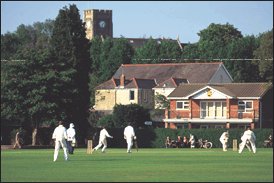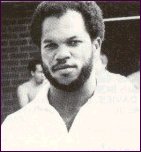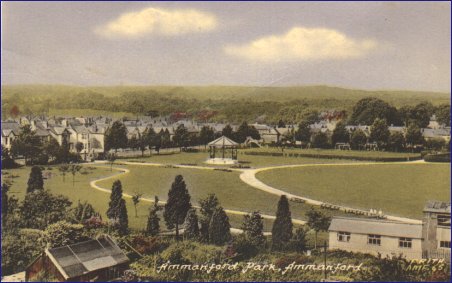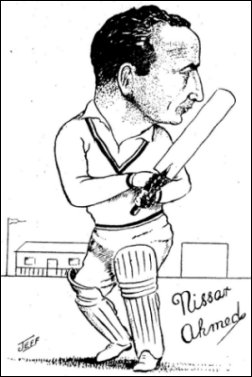AMMANFORD CRICKET CLUB"Cricket – a game which the English, not being a spiritual people, have invented in order to give themselves some conception of eternity." [Lord Mancroft (1914-1987) from 'Bees in Some Bonnets', 1979, page 183.]
NEARLY A CENTURY AND A HALF
OF CRICKET IN AMMANFORD
By Dr Martin RhysClwb Criced Rhydaman
'Yma O Hyd' [Still Here]Ask the cricketers who play in the South Wales League on which ground they prefer to play their matches and more than likely you will get the same answer over and over again: Ammanford Park.
Hardly surprising, really. Firm, true wicket; fast, flat outfield; first-rate clubhouse with two balconies overlooking a park colourfully resplendent with trees, shrubs and flowers of different hues; a discerning public eager to see a good class of cricket; and by 7pm on a Saturday evening the appetising smell of exotic cuisine wafting across the arena from the town's three Indian restaurants.
Where else would anyone want to play, for goodness sake?
Yet it was not ever thus. The club has enjoyed an unprecedented run of sixteen consecutive seasons in the top flight of the South Wales League—recognised as one of the most competitive Leagues in Britain—but it took a long time to get there.
The first reported game of cricket played at Ammanford was, typically, some time before the town of Ammanford came into existence. The place was then known as Cross Inn in the parish of Llandybie, and the match that took place in July 1853 was played over two innings between Cross Inn and Cwmaman. The match report makes fascinating reading:
"A Cricket Match was played at Cross Inn, on Tuesday last, between the Cross Inn and Cwmamman Clubs. The Cross Inn Club took the bat first, and scored 34 runs. The Cwmamman Club went in and played a tie. The Cross Inn followed and scored 38. The Cwmamman Club went for their last innings, and scored 34 again. After the game had terminated, most of the gentlemen proceeded to Mr Wm Howells, of the Cross Inn, where every accommodation and good refreshment was found."
Current members of Ammanford Cricket Club will note similarities to and differences from the present situation. First, the batting hasn't improved that much; the post-match refreshments are still de rigueur, though the reference to "gentlemen" will prove puzzling to most.
So cricket has been played at Ammanford for almost a century and a half. The inauguration of the club took place in 1886, though the centenary was celebrated in 1975. The belief that the club was formed in 1875 probably stemmed from a July entry in the log book of the local primary school which recorded that pupils were given an afternoon off school in order to watch an Ammanford team play a visiting side.
Play up! play up! and play the game. A leisurely game in progress on Ammanford Park, with Ammanford Bowls Club pavilion in the background and All Saints church behind that. The Club's first secretary was a Councillor David Jones of High Street, which is where another treasurer, Hywel Rees, lived until recently. It is also rather a neat irony that the first recorded match should be against Cwmaman since the present Chairman, Wyn Jones, and Secretary, Neil Hobbs, both hail from the Cwm.
The impetus which established Ammanford as a cricketing locality was the coming of the coal industry which naturally attracted work-seekers from all over Wales and beyond. Several Lancashire folk came to the area, bringing with them a missionary zeal to spread the cricket gospel among the locals. Names from that era have a distinctly un-Welsh cadence: like Ernie Hewlett, Jim Darbyshire and the Cooke brothers.
The home of Ammanford cricket is the Park, and it is difficult to imagine it anywhere else. But that's not where it all began. Back in 1882, Cross Inn played their matches in Tirydail on a field adjacent to Afon Llwchwr – where the CCTA now stands. Captain at that time was a gentleman by the name of Arthur Morris who was one of the principals of the Pontaman Chemical Works. In his team was C. P. Lewis who captained Wales in their second rugby international match against Ireland. (Arthur Morris was also the man responsible for the founding of Ammanford Rugby Football Club in 1887)
The move to the Park – at the time known as the Cross Inn Field – was made at the turn of the century. Around this time the team contained a bowler by the name of Huw Morris who used to bowl underhand with considerable success—present players please take note. On the fixture list was Llandovery, against whom we used to play for high stakes—dinner, with losers to pay. I wonder if Jonah's chip shop was around then?
A couple of months ago we honoured our retired President Tom Handel Richards for his long service to the Club. Tom, who became president in 1979, will be delighted and not in the least bit surprised to learn that he follows in some pretty noble footsteps. Amongst our earliest presidents was one Lt. Col. W N Jones of Duffryn whose son Harold captained the side in the 1920s. During the Depression of the 1930s we were fortunate enough to have the services as president of J Owen Parry OBE, who probably kept the club solvent during this decade of severe privation, and also made his two cars (two cars! in the 1930s!) available as transport for the players. Oh for such a benefactor now ...
The payment of professionals in an essentially amateur club is a perennially thorny issue, but the engagement of professionals at Ammanford Cricket Club has a long history. It used to be part of the professional's duties to prepare the wicket and outfield for each match. Can you imagine today's pros getting out of their sponsored Volvos with names emblazoned along the side to drive our heavy roller – the mystery of whose operation incidentally is known only to the members of a secret society consisting of two people? For years the square was rolled by a horse-drawn roller: the horse, which wore foot-pads when working on the square, was owned by the club. The more abrasive of our supporters would comment that today all we have is the donkeys in the team ...
Some famous names have graced the Park as professionals for Ammanford, but one of cricket's most famous names didn't quite make it. In 1955, the legendary West Indian Frank Worrall nearly came to the club. Local trades people were prepared to guarantee his match fees, but he decided instead to go to the Lancashire League. Nissar Ahmed was engaged instead of him (see below for a brief biography of Nissar Ahmed). He was followed by David Evans, Alan Rees and Len Hill of Glamorgan, but without doubt the best known Ammanford professional was, before his arrival, an unknown.
Linton Aaron Lewis in his playing days for Ammanford and Glamorgan Second Eleven in 1983. Later he would become Dr. Linton Lewis and is now a lawyer and businessman in his native St Vincent. He was a parliamentary candidate for the island's opposition New Democratic Party in the December 2005 general election. Photo © 2005 Glamorgan CCC. Linton Lewis came to Ammanford as the result of an inspired committee decision under the guidance of dedicated secretary Don Phillips to gamble on a young West Indian hopeful. He arrived in 1981, when Ammanford were languishing in the depths of the third division. Within three years, Ammanford were champions of Division 1 and had won the Welsh Cup twice. In 1986, the Club achieved the double of becoming Division 1 Champions and Welsh Cup Winners. Ammanford Cricket Club—and Linton Lewis—had arrived. Club and professional grew together in reputation. Ammanford Park became a focal point for hundreds of cricket fans from all over South Wales, and often beyond. Only last summer I remember talking to an archaeologist from Durham University who could remember making a trip to Ammanford Park to watch Linton play. And who could blame him? Records were set in the 1980s which will probably never be broken. Up until that time, nobody had ever scored 1,000 runs in the League. In 1983, Linton amassed 1,543 runs including seven centuries. Several immensely talented batsmen—amongst them Gordon Greenidge and Richie Richardson—have graced the Park with magnificent power and elegance, but never was there such a complete destroyer of bowling attacks as Linton.
Linton left in 1989, much to the relief of the Park's bowling green regulars who had taken to wearing crash helmets during the first XI's home matches. But Ammanford had set a trend which was taken up by other clubs in the South Wales League. Overseas professionals were appearing everywhere. Standards were high, but home-grown talent was being stifled, and the League called a halt. Overseas players were initially banned, but this Draconian measure was later modified to one and which required them to have lived in the locality for 18 months prior to registration.
Linton's legacy was double-edged. On the downside, less magnanimous rivals labelled Ammanford a one-man team, an allegation which our continued presence in the top flight a decade later has shown to be unfounded. One of the many benefits was a second storey to our pavilion.
The Club's first pavilion was situated where the tennis courts are now. It was always painted green and white – the club's colours. When the bowling green and tennis courts were built, the Club used a big tent as a temporary pavilion. In the early 1950s a new pavilion was built on the present site, the brainchild of one Roy John. Roy came from Llangennech to Ammanford and, after being demobbed from the army, devoted much time and energy to the Cricket Club. He was often seen rolling the square at 5am to catch the dew, an endearing eccentricity recently adopted by our current groundsman. The pavilion cost £140-8-8 to build. In 1972 it was burnt to the ground, set alight by the sparks from a nearby garden waste fire. Again the legacy was double-edged: on the downside, we lost all the Club's records in the shape of photographs, scorebooks and committee meeting minutes; on the upside, we got ourselves a new pavilion.
We deserved a bit of luck at this stage in our history. The Club's fortunes were at a low ebb: playing in the third division, a dwindling committee and no income. There was no income because there was no bar and, since the Park is a public one, no admission charges. (Rumour has it that the Club was offered the opportunity back in the early 1920s of purchasing the Park for some £60,000, a sum outrageously out of its reach. But what an investment it would have been.) Outside help was sought for the building of a new pavilion. Grants eventually came from the Sports Council and Carmarthenshire County Council, but the main rescue job was done by the newly formed Dinefwr Borough Council who came in with a grant and a loan. They also allowed the Club temporary use of the tennis pavilion, temporary turning out to be three seasons.
Ammanford Cricket Club is now a worthy sporting focus for the townspeople, particularly on fine summer afternoons and evenings when you can enjoy a drink on the pavilion's balcony while watching the shadows of the cricketers lengthen as the sun descends beyond Iscennen, beyond Tirydail, even beyond Llandybie. But it is not the pavilion nor even the Park itself that Ammanford Cricket Club is all about. The Club is about the people who have given so much of themselves to ensure the Club's success in the good times, its very existence in the bad. It would be foolish and futile to even attempt to name them. The pride of Ammanford Cricket Club is their testimony.
(The above article was Written on 22/03/2001 by Dr Martin Rhys of Ammanford)
NISSAN AHMED OF PAKISTAN
Nissan Ahmed. Cartoon by Jeff from the South Wales Guardian, 3rd May 1956. Many overseas professional cricket players made their living by playing in the professional cricket leagues found all over Britain. Strict residential rules had to be met for qualification for the County Cricket Clubs and non-British players weren't eligible to play county cricket at all until recent decades. The most famous of the 'leagues' was the Lancashire Cricket League (founded in 1892) where many world-class test players were able to earn a living. Of the many overseas players who have graced its cricket grounds are the West Indian internationals Sir Learie Constantine, Frank Worral, Charlie Griffith, Wes Hall, George Headly, Michael Holding, Clive Lloyd, Viv Richards, Andy Roberts and Everton Weeks. Australian test players include Shane Warne, Steve Waugh and Jason Gillespie. India has provided Kapil Dev, and the South Africans Basil Doliveira and Allan Donald have also played in the Lancashire League.
But other cricket leagues throughout Britain employed overseas professionals and the South Wales leagues were no exception. Nissan Ahmed joined Ammanford Cricket Club in 1955 as club professional and is another player of genuine first class ability to have played for the club. He was a product of the cricket leagues in Pakistan which in 1955 was still a new country, having been created from the partition of India on independence in 1947. Nissan was a former member of the Pakistan State Railway Cricket Club who played in Inter-Zone Cricket in Pakistan, and was awarded his Inter-Zone cap. He first played at Ammanford with the Pakistan Eaglets in 1954. He was then a wicket-keeper, reckoned in Pakistan to be near-Test class. He was engaged as the club's professional in the 1955 season as player-coach, and did excellent work in both capacities until illness overtook him about mid-season 1955.
He headed the bowling averages in the First Division of the South Wales and Monmouthshire League for the 1955 season by taking 24 wickets for an average of 7.79, and was highly placed in the batting averages as well. He returned to Pakistan in the winter of 1955.
(Source: South Wales Guardian, 3rd May 1956, Player Profile 17.)
CRICKET AT THE PARK UNDER THREAT
It's taken for granted now that the Park is the natural home of Ammanford Cricket Club but the sound of leather on willow wasn't always welcome there. Before the Second World War the council who owned the park put a stop to cricket, causing the local newspaper to reminisce in 1939 about the Cricket Club:
"... which used to provide the people of Ammanford with happy Saturday afternoons. The Park of today is simply a lawn, perhaps on a larger scale, and it holds little attraction except for the few". [Amman Valley Chronicle].
This was the still case in 1940 when an attempt was made by Ammanford Cricket Club to reverse the local council's ban of cricket on the park. The arguments for and against were aired at a meeting of Ammanford Urban District Council (UDC) in April 1940:
... the Park had been in the possession of the Council since 1920, and the members of the Council knew the reasons why the Cricket Club had been asked to give it up.
....One was that the playing of cricket on the Park was dangerous to children, and then there was the question of a certain amount of damage being caused through the balls being hit into the Bowling Green. (Amman Valley Chronicle, 11th April 1940.)Very soon however we are given the real reason for the Council's reluctance to allow cricket on the Park, and it wasn't concern for the safety of local children at all. The possibility of being sued if a child were killed figured larger in their calculations than any child's health:
Mr. Frank Davies asked what was the position of the Council were a child struck and killed by a cricket ball on the Park. Were they covered by insurance?
....The Clerk replied that the Council now had a comprehensive policy which would cover any liability that might arise. (Amman Valley Chronicle, 11th April 1940.)Another councillor offered further objections:
W.L. Hitchings remarked that he was not against the playing of cricket. He had always been interested in sport, but if the Cricket Club were again given the use of the Park, it would mean a disappointment for a large majority who enjoyed themselves there last summer in safety. (Amman Valley Chronicle, 11th April 1940.)
Yet another objection was the use of the Park for evening cricket practice:
Mr. Frank Davies asked whether the Cricket Club would be prepared to confine their practices to one or two nights a week. The objection he had was that cricket was being played on every night of the week. (Amman Valley Chronicle, 11th April 1940.)
The final plea from the cricket club seemed to sway Ammanford UDC in their favour:
All they asked for was the use of the field for some five hours on a Saturday and a few hours for practice on week nights.
....Undoubtedly there was a big majority in the town who enjoyed a game of cricket, and enjoyed the fine spectacular and thrilling incidents in the matches played on the field on Saturday afternoons.
....They had made themselves arrangements for another field and while it was true that they were indebted to the Council for rent, they had had no opportunity of honouring their obligations.
....It was their desire to meet their obligations, but unless they could find a playing field, they would not have the opportunity of doing so.
....He appealed to the Council to give them a chance to play on the field for another season and during the war. (Amman Valley Chronicle, 11th April 1940.)But no sooner had the cricket club won this particular battle than another row over the building of a pavilion broke out, as the local paper reported:
OPPOSITION TO SITE FOR CRICKET PAVILION
Amman Valley Chronicle
6th June 1940Mr. Frank Davies said that as he was coming along to the Council meeting that evening he noticed that they had started building the pavilion on a portion of the field which was unsuitable and which would make the field unsightly.
....Mr. Davies went on to say that if the pavilion was allowed to be erected at that spot, it would be most unfair to the residents of Tirydail Lane, and he asked that it be erected on another site where it would not be an obstacle to anyone.
....If they allowed it to be erected on the site now proposed, he assured them that there would be a rumpus in the town, and the residents of Tirydail Lane would protest. He understood that the Cricket Club did not object to a site he had in mind, that was, at the rear of the Welfare Hall.
....He moved that no further work be done there, and that they agree to the alternative site he had mentioned.
....Mr. John Thomas supported Mr. Davies.
....Mr. John Owen Parry said that when the Council were good enough to allow the Cricket Club to put up a pavilion, he had himself a site in mind that was, under the old tree. When he discussed the matter with the groundsman, he suggested this to the groundsman as the best place.
....He (Mr. Parry) quite understood the objection raised, but they had started to erect the pavilion on the site allocated them by the Committee, who had been given plenary powers in the matter.
....The Cricket Club were in no way to blame and he assured them that they were agreeable to the suggestion of Mr. Frank Davies.
....The motion of Mr. Frank Davies was carried.It would seem from all this that the residents of Tirydail Lane, then a street where Ammanford's better-off residents lived, were influential enough to prevent what they saw as an unsightly cricket pavilion being built in their view. Ever since then the cricket club's three pavilions have all been situated conveniently out of sight behind the local Miners' Welfare Hall.
A separate history of Ammanford Park can be found in the 'History' section of this website or click HERE.




